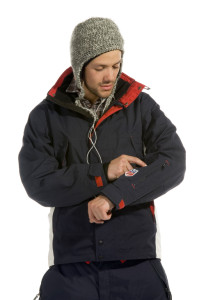When we think “wearable technology” we may think of photovoltaic materials powering small electronic devices, or sensors relating vital signs to health care providers. About a year ago, U.K.-based Peratech announced its involvement in a new project, dubbed “Nose in clothes.”
Doctoral candidate Anne Prahl, a student at the London College of Fashion, University of the Arts London, is researching wearable sensors that would indicate the presence of dangerous chemicals and monitor the wearer’s vital signs for indications of illness.
 Prahl’s project is underpinning a wider wearables project involving Peratech, a company distinguished by its innovations in touch technology, to develop wearable electronics that use Peratech’s quantum tunneling composite (QTC™) sensors. QTCs are composite materials of metals and non-conducting elastomeric binder, used as pressure sensors. They use quantum tunneling, a technology to apply pressure to move the conductive elements of these materials closer together, so electrons can “tunnel” through the insulator. Classical electrical resistance is linear, proportional to distance. Quantum tunneling is exponential with increasing distance.
Prahl’s project is underpinning a wider wearables project involving Peratech, a company distinguished by its innovations in touch technology, to develop wearable electronics that use Peratech’s quantum tunneling composite (QTC™) sensors. QTCs are composite materials of metals and non-conducting elastomeric binder, used as pressure sensors. They use quantum tunneling, a technology to apply pressure to move the conductive elements of these materials closer together, so electrons can “tunnel” through the insulator. Classical electrical resistance is linear, proportional to distance. Quantum tunneling is exponential with increasing distance.
QTCs have been implemented in apparel for touch control panels that can be used in extreme weather conditions or spacesuits. The high cost of QTCs have restricted their use in wider markets.
According to Prahl, her project consists of three key research areas:
- Material: Textile design and technology integration
- Form: Inspired by stimuli location for in-situ monitoring, and
- Function: Probing the capabilities of the QTC technology in the context of designing for a real user need
In the last year her research has mostly focused on exploring and developing suitable materials which can act as the technology carrier, and investigating potential user needs with the particular focus on wearable “e-noses” which can function as an early warning system for the wearer.
This includes both protection from external or environmental stimuli, such as indoor and outdoor pollution and electromagnetic radiation; and/ or detection, monitoring and early diagnosis based on internal stimuli, coming directly from the wearer’s skin. (A video, a presentation to the Quantified Self community in London, explains it in more detail. https://vimeo.com/79009267.)
Here’s how Peratech’s printable QTC™ E-nose sensors work: The QTC material expands in the presence of VOCs, which changes the resistance of the QTC material, giving very rapid response and recover times and a high level of sensitivity. Different formulations can be made according to the specific VOC to be detected so that low-cost warning sensors and the associated electronics can be printed onto textiles to provide clothing that monitors the wearer for signs of illness, fatigue or exposure to dangerous chemicals.
The next six to eight months of her practice-based research will focus on the actual design and development of the wearable e-nose concepts.
Photos are provided by Peratech and illustrate examples of Peratech’s work in wearable technology.
 TEXTILES.ORG
TEXTILES.ORG



